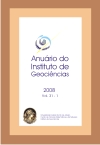Augen gneiss: the more carioca of the rocks
DOI:
https://doi.org/10.11137/2008_2_9-22Abstract
The city of Rio de Janeiro is known by its natural beauties. The mountains and the sea make the city the postcard of Brazil. The sculpture of the carioca landscape is closely related to the augen gneiss, very resistant rock to the weathering and, for this reason, it stands out in the relief. It gives form for Sugar Loaf and Corcovado, for example. Augen gneiss was used in the construction of most of the historical buildings of the city, including museums and churches, many of them were built in the 19th century. It was used in the sculpture of ornaments, facades and frames of doors and windows. The exploitation of the augen gneiss was presented by Jean Baptiste Debret in his book "Voyage Pittoresque et Historique au Brésil". A picture of quarry is presented at Morro da Glória and describes the extraction method by slave labor. He informes that the augen gneiss is softer, less expensive and more easily exploited. It was destined, mainly, to the parts of the buildings that should be sculpted. This rock is still present in an important event of the history of the brazilian arts. Pedra do Sal, a stairway sculpted in the augen gneiss Downtown, was the place that African people met in the past to tell their histories, to do religious cults and to sing. In these meetings in Pedra do Sal samba was bornDownloads
Download data is not yet available.
Downloads
Published
2008-12-01
How to Cite
Mansur, K. L. (2008) “Augen gneiss: the more carioca of the rocks”, Anuário do Instituto de Geociências. Rio de Janeiro, BR, 31(2), pp. 9–22. doi: 10.11137/2008_2_9-22.
Issue
Section
não definida
License
This journal is licensed under a Creative Commons — Attribution 4.0 International — CC BY 4.0, which permits use, distribution and reproduction in any medium, provided the original work is properly cited.















